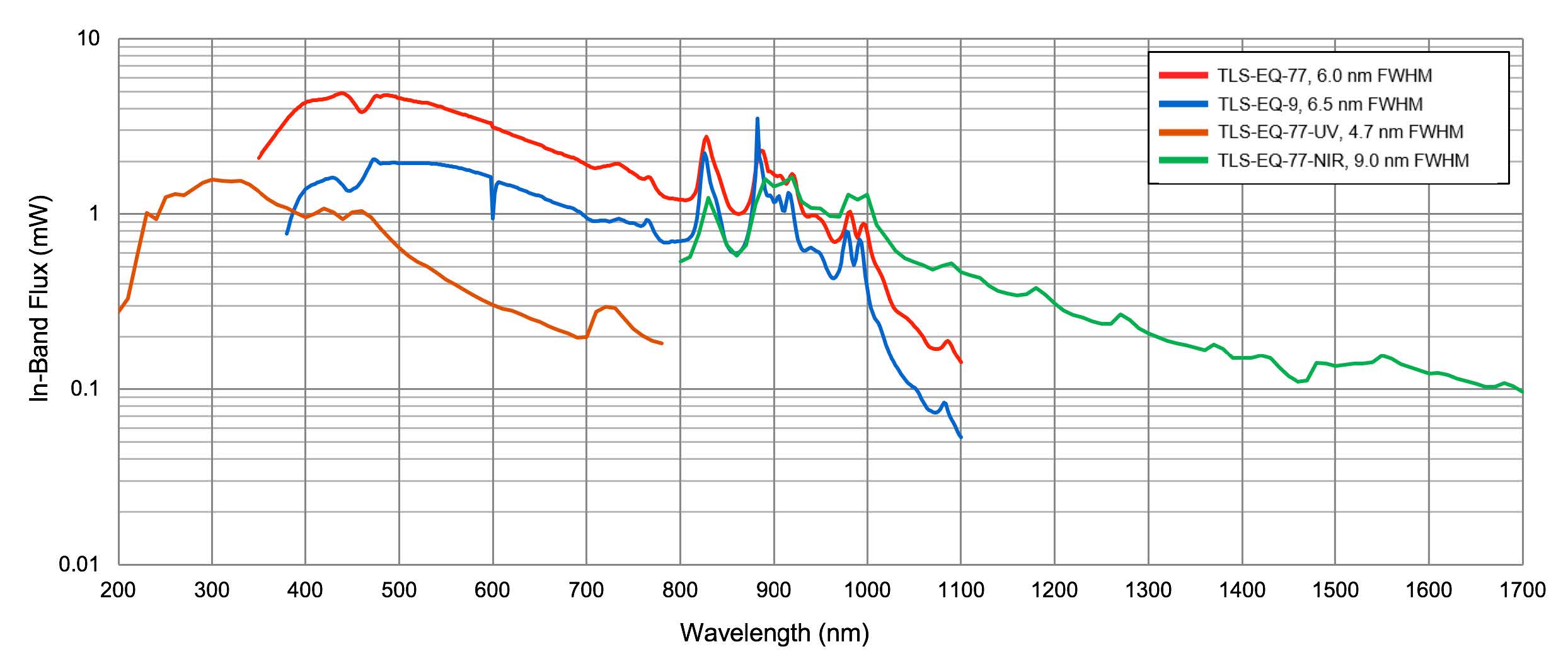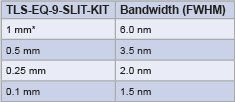Answers to Your Top LDTLS® Questions
We’re here to help answer all of your Laser-Driven Tunable Light Source (LDTLS®) questions. While the data below is based on typical values, we’re happy to provide more detailed specifications. Select a topic below to jump to the common questions we receive on that subject.
How do I request a quotation?
Hamamatsu Photonics distributes LDTLS and LDLS products for most countries. Please visit our contact us page or the Hamamatsu website to submit a request for a quotation or send an email to info@energetiq.com.
For information about the Electrodeless Z-Pinch™ EUV sources, please email info@energetiq.com.
Are custom configurations available?
Custom configurations are available to meet stringent OEM application requirements. Please contact us at info@energetiq.com to initiate a discussion.
What is the lifetime / output degradation of an LDTLS system?
We recommend changing the bulb in an LDTLS system after 10,000 hours of operation or on an annual basis.
We define the lifetime of the lamp / bulb as when the intensity has dropped more than 50% at 500 nm. The spectral output at 500 nm decreases about 1% - 2% every 1,000 hours under standard operating conditions with nitrogen purging.
How do I initiate an RMA?
Contact your local Hamamatsu office or distributor for service requests. If you are unsure who your contact is, email us at service@energetiq.com for assistance.
What is the standard warranty for an LDTLS system?
The standard warranty is 12 months. Extended warranties are available for certain models and circumstances.
What is the warm-up time of an LDTLS system?
We recommend a warm-up time of approximately 30 minutes before taking measurements to ensure that the LDTLS system has reached thermal equilibrium. The actual warm-up time for an application may be longer or shorter depending on the precision of measurements to be made.
Do LDTLS systems require external cooling?
The TLS-EQ-9-S includes an integrated fan, and no external cooling hardware is required.
The TLS-EQ-77 models require water cooling with a flow rate of approximately 0.5 liters per minute at a temperature between 18 and 30 degrees Celsius. Listed below is a suitable chiller that can be directly purchased through your local Solid State Cooling, Inc. representative or through Energetiq (Part Number: EQ-77-CHILLER-KIT).
- Solid State Cooling Systems Model UC190 Ultra Compact Chiller (190 Watts)
What is the wavelength range of LDTLS systems?
TLS-EQ-9-S
- 380 nm – 1100 nm
TLS-EQ-77-S
- 350 nm – 1100 nm
TLS-EQ-77-UV
- 200 nm – 770 nm
TLS-EQ-77-NIR
- 800 nm – 1700 nm
What is the in-band flux of the LDTLS systems?
LDTLS Model | Maximum and Average In-Band Flux
TLS-EQ-9-S*
- Maximum – 3.5 mW at 882 nm
- Average – 1.1 mW
TLS-EQ-77-S*
- Maximum – 4.9 mW at 440 nm
- Average – 2.3 mW
TLS-EQ-77-UV**
- Maximum – 1.6 mW at 300 nm
- Average – 1.1 mW (200 nm - 500 nm)
TLS-EQ-77-NIR*
- Maximum – 1.6 mW at 920 nm
- Average – 0.44 mW
* 1500 μm core diameter fiber optic cable
** 600 μm core diameter fiber optic cable

What is the scan speed and minimum step size of LDTLS systems?
The scan speed of LDTLS systems is <20 ms for a 2 nm step. 2 nm is the smallest step size.
What is the typical accuracy of the wavelength sweep of the LDTLS systems?
The TLS-EQ-77-S has a typical wavelength accuracy of ± 0.5 nm, while the TLS-EQ-9, TLS-EQ-77-UV, and TLS-EQ-77-NIR have a typical wavelength accuracy of ±1 nm.
How is the LDTLS system/monochromator controlled?
For the TLS-EQ-9-S and TLS-EQ-77 models, we offer a LabVIEW-based PC application that provides a convenient user interface to allow the customer to control the system. We also provide Dynamic Link Library (*.dll) files that allow the user to develop their own controls. The system interfaces with Windows operating system through a Mini USB connector.
The LDTLS system can be used in two modes: go-to-wavelength or cycle/sweep. The user is also able to adjust the filter wheel transition for the order sorting filter.
What is the spectral resolution (bandwidth, full width at half maximum) of the LDTLS systems?
The FWHM bandwidth and in-band flux of the tunable light sources depend on the slit size used in the monochromator.
The TLS-EQ-77-NIR has a standard 1 mm slit resulting in a 9.0 nm FWHM. The TLS-EQ-77-UV has a 1 mm slit with a narrower 600 um fiber resulting in a resolution of 4.7 nm FWHM. The TLS-EQ-77-S slit size cannot be adjusted.
For the TLS-EQ-9-S, the standard slit width is 1 mm which results in a 6 nm FWHM bandwidth. We offer a supplementary slit kit (Part number: TLS-EQ-9-SLIT-KIT) with three additional slit sizes that can be changed by the user.

*Standard slit size
What is the Numerical Aperture (NA) of the output fiber on each of the LDTLS systems?
LDTLS Model | Numerical Aperture
- TLS-EQ-9-S — 0.39 NA
- TLS-EQ-77-S — 0.39 NA
- TLS-EQ-77-UV — 0.39 NA
- TLS-EQ-77-NIR — 0.39 NA
What fiber optic cables should be used with my LDTLS system?
We recommend that customers use the fiber shipped with their system for optimal performance. The standard fiber was chosen based on the characteristics of the source and typical application requirements.
Other fibers can be used; however, the diameter and type of fiber should be chosen carefully. A fiber with a diameter that is smaller than the width of the monochromator slits will reduce the spectral bandwidth and light throughput of the system. Some fiber materials may absorb different wavelengths of light, impacting the spectral output of the system.
Fibers Compatible with TLS-EQ-9, TLS-EQ-77, and TLS-EQ-NIR

Do the LDTLS systems require nitrogen purge?
We recommend purging using a grade of 4.8 nitrogen or higher filtered to 5 μm to maintain the optics’ cleanliness. Any lower nitrogen grade may cause complications for the lamp head optics and could cause a photo-contamination. Nitrogen purging of the EQ-77 lamp head is particularly important for the TLS-EQ-77-UV to maintain UV output.
What pressure is required for the dry nitrogen purge?
The inlet pressure of nitrogen supply should be set at 20psig (0.14 MPa) for all LDTLS models.
Can you purge with other gases besides nitrogen?
No. Only high-purity nitrogen can be used to purge the LDTLS systems.
Can you put a vacuum on the lamp head instead of purging with nitrogen?
No. The LDTLS systems will not hold a vacuum and connecting to a vacuum may cause damage to the optics.
Can I use the LDTLS system in a cleanroom environment?
It is not required. However, the standard operating environment for LDTLS is in a cleanroom with nitrogen purging.
Are LDTLS systems laser products?
No. During all normal operation of the LDTLS system, there is no laser output. Our products create incoherent broadband radiation. In a contained system, a laser is used to sustain a xenon plasma. The radiation exiting the LDTLS system is from the plasma.
What Laser Class are LDTLS systems?
LDTLS Model | Laser Class
- TLS-EQ-77-VIS — Class 1 (IEC 60825-1: 2014)
- TLS-EQ-77-NIR — Class 1 (IEC 60825-1: 2014)
- TLS-EQ-77-UV — Class 1 (IEC 60825-1: 2014)
- TLS-EQ-9-S — Class 1 (IEC 60825-1: 2014)


